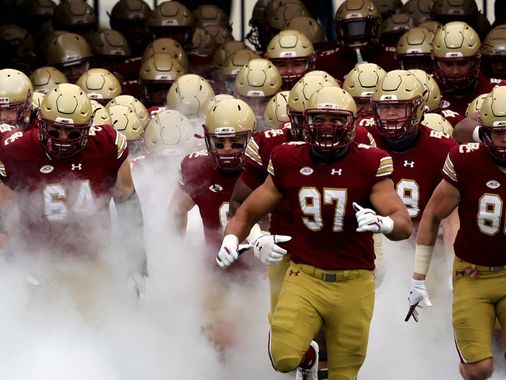What are USC and UCLA doing in the Big Ten? What are Texas and Oklahoma doing in the SEC? Is the ACC seriously talking about bringing in Cal and Stanford?
And that’s what we remaining fans of big-time college sports are. For anyone over the age of, let’s say, 20, the world of college sports is not the one we once knew and loved.
I’ll still watch the games. At least I think so. It’s what enablers do.
For that matter, what is Boston College doing in the ACC? It turns out our beloved Eagles were the canary in the mine shaft when they abandoned the Big East — a basketball conference of which they were a founding member — in favor of the ACC, itself a basketball conference then in the process of being hijacked by football.
Advertisement
Conferences once made sense. Consider an entity created more than a century ago as the Pacific Coast Conference. As the Pac 8, what could have been more logical? Two teams in the state of Washington. Two teams in Oregon. Two teams in the Bay Area. Two teams in Los Angeles. Scheduling and travel couldn’t be simpler. Expand by incorporating two teams from Arizona. Why not?
Get Sports Headlines The Globe’s most recent sports headlines delivered to your inbox every morning. Enter Email Sign Up
It was truly the perfect conference.
As you may or may not know, the once-proud Pac 8/10 found out this week it would be down to just four: Washington State, Oregon State, Cal, and Stanford, which means it would cease to exist. Cal and Stanford going wherever won’t matter.
For those of you keeping score, if everything happens to plan by the year 2024, the SEC will have 16 teams, the Big 12 will have 16, and the Big Ten will have 18. Explain that to your kids.
Oh, and before I forget: Can anyone tell me how a future Big Ten conference stretching from Los Angeles to New Brunswick, N.J. (Rutgers) can schedule its non-revenue sports? Or does anyone care?
Advertisement
Stanford and Cal are two of just four remaining teams in what used to be the formidable Pac-12. Godofredo A. Vásquez/Associated Press
Again I feel compelled to remind you that the concept of big-time college sports is unique to America. We are the only nation in which our institutions of higher learning routinely provide entertainment for the masses. Canada? College sports in our friendly neighbor to the north are not a major item on most people’s sports menus. Accomplished adolescent basketball players have no choice but to come down here to play.
Now we all realize that the current madness that has engulfed college sports is easily explained. It has to do with the frantic pursuit of a five-letter word that begins with “M” and ends with “Y.”
The assumption is that people want to see the games and TV wants programming. It also happens that the big money sport is football. The Pac 10′s demise is due to its inability to negotiate a sufficiently lucrative TV contract that would allow it to compete with Power 5 conference rivals Big 12, SEC, Big Ten, and ACC. Henceforth, the Power 5 will be a Power 4.
Concurrent with all this are two items that have upset whatever semblance of order once existed in big-time college sports: the Name-Image-Likeness (NIL) policy and the transfer portal.
For most of the 20th century and into the early 21st, the colleges playing football and basketball on a high level sold the public on the premise that the young men (until recently, women were not a factor) were legitimate students playing these sports while attending school on scholarship and they should be grateful for that privilege. But from the beginning, people pushed various envelopes.
Advertisement
In the 1890s, people spoke of the so-called “tramp athletes” who sometimes played for one school this week and another the next. Winning always was paramount. The NCAA itself basically came about because no one trusted anyone and rules needed to be established.
The mythology was encoded when legendary NCAA chief Walter Byers came up with the phrase “student-athlete” to ensure that the players could not be termed “employees” and thus be subject to possible legal involvement.
Well, we lurched into the 21st century perpetuating the “student-athlete” concept. Then a funny thing happened. Coaching salaries, for decades in the five figures (John Wooden retired in 1975 while making $32,500 a year), moved past the six-figure range into the sevens. Players such as UCLA’s Ed O’Bannon discovered their images and likenesses being used in video games without them being compensated and rightfully said, “Where’s mine?”
Making direct payments to players was always logistically unfeasible — does the starting quarterback get more than the backup tight end? — but we have now arrived at a juncture where players can indeed cash in on their image and likeness with endorsements, appearance fees, etc. Thus the rich can get richer by enticing players with help from boosters and local business folk. The ramifications of the NIL thing are just beginning to be felt. But they will be profound.
Advertisement
New NCAA president and former Massachusetts governor Charlie Baker has emphasized his plans to address NIL legislation. Darren Abate/Associated Press
As for the transfer policy, “insanity” doesn’t begin to describe the climate. Suffice it to say that the unofficial operative phrase college coaches and administrators use to describe it is “The Wild, Wild West.”
Many schools now employ someone whose sole responsibility is to monitor the landscape in search of possible transfer targets. We’ve already had a Final Four participant play for four schools in four years, and he won’t be the last. I wonder how many classrooms he accidentally wandered into?
Full disclosure: I’ve been following college sports since my father, then the assistant athletic director at Villanova, first took me to the Pennsylvania Palestra in 1952. I feel very proprietary about college sports. Or, at least, I did.
Now? It just feels wrong, somehow. Yes, and please stop insulting our intelligence with this “student-athlete” nonsense. Those days, if they ever existed, are gone.
Deion Sanders U vs. TCU on Sept. 2. I’ll probably watch. It’s what an enabler would do.
Bob Ryan can be reached at robert.ryan@globe.com.




